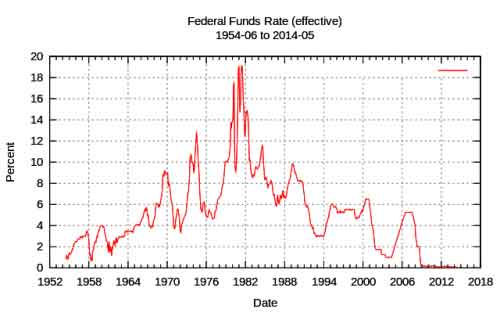Will the Federal Reserve’s interest rate increase, announced Dec. 16, limit the solar market’s ability to access capital and build projects? The short answer is no, according to experts interviewed on the subject. Here is why solar developers and installers can relax, at least for now:
The rate increase, from 0% to .25% for short-term, bank-to-bank lending, remains fundamentally low. For comparison, interest rates before the Great Recession, when they plummeted to 0% for the first time, hovered around 5% and reached into the upper-teens between the late 70s and early 80s.
 The rise and fall of Federal Reserve interest rates. Credit: SolarPowerWorldOnline
The rise and fall of Federal Reserve interest rates. Credit: SolarPowerWorldOnline
Additionally, solar is a good, low-risk investment, according to Graham Smith, founder of commercial-solar financing platform Open Energy. Smith said last week’s rate increase will not impact the cost of loans through his platform.
“We still see a fundamentally stable environment,” Smith said. “These long-term cash generation assets and their risk is fundamentally unchanged.”
Making their first update to monetary policy in nearly a decade, the Fed board increased rates to stave off inflation. Members made the decision now because they felt the economy was sufficiently healthy and inflation was not a negligible risk. World markets had been anticipating a change.
When the Fed increases rates, effects ripple through the global economy. The “cost of money”—otherwise known as the interest rate on loans—increases throughout the market, affecting everything from mortgage loans to debt capital for solar projects, said Conlan O’Leary, CEO of Sighten, a software toolset for solar.
“So in a low interest rate environment, which is what we’ve been in since the financial crisis, that price has been low, so derivative prices for solar finance have been low, too,” Conlan said. “That’s been a boon to developers who could get capital on favorable terms. As interest rates rise, those rates will all rise somewhat.”
Yet, Conlan said, rates are still abnormally low, and the Fed’s increase was minimal.
“I think for a rate increase of this magnitude, I would not worry about it at all,” said Conlan. “If the rate environment dramatically changes over a short period of time, as would be the case with a number of rate hikes within a year or two, that could materially impact the cost of financing.”
Smith said further calming worries and limiting the potential impact of a rate increase was the Fed’s strategy of long-telegraphing the impending hike, which let lending institutions recalibrate for the increase. He would expect the Fed to signal further increases.
“The Fed is aware of the impact it has,” Smith said. “If they had to raise rates by 1%, which is extremely unlikely, they would tell the market, they wouldn’t do it overnight.”
Sudden changes in interest rates might limit the amount of money a solar developer or installer could afford to build solar projects. But for now, with the ITC extension in the background, it appears money will be relatively easy to come by.
Reference:
This article has been published here with permission by the PVBuzz Media team from the original article written by Steven Bushong and published on Solar Power World Online.














Comments